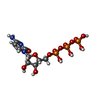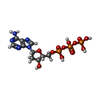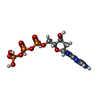+Search query
-Structure paper
| Title | Nucleotide binding to the ATP-cone in anaerobic ribonucleotide reductases allosterically regulates activity by modulating substrate binding. |
|---|---|
| Journal, issue, pages | Elife, Vol. 12, Year 2024 |
| Publish date | Jul 5, 2024 |
 Authors Authors | Ornella Bimai / Ipsita Banerjee / Inna Rozman Grinberg / Ping Huang / Lucas Hultgren / Simon Ekström / Daniel Lundin / Britt-Marie Sjöberg / Derek T Logan /  |
| PubMed Abstract | A small, nucleotide-binding domain, the ATP-cone, is found at the N-terminus of most ribonucleotide reductase (RNR) catalytic subunits. By binding adenosine triphosphate (ATP) or deoxyadenosine ...A small, nucleotide-binding domain, the ATP-cone, is found at the N-terminus of most ribonucleotide reductase (RNR) catalytic subunits. By binding adenosine triphosphate (ATP) or deoxyadenosine triphosphate (dATP) it regulates the enzyme activity of all classes of RNR. Functional and structural work on aerobic RNRs has revealed a plethora of ways in which dATP inhibits activity by inducing oligomerisation and preventing a productive radical transfer from one subunit to the active site in the other. Anaerobic RNRs, on the other hand, store a stable glycyl radical next to the active site and the basis for their dATP-dependent inhibition is completely unknown. We present biochemical, biophysical, and structural information on the effects of ATP and dATP binding to the anaerobic RNR from . The enzyme exists in a dimer-tetramer equilibrium biased towards dimers when two ATP molecules are bound to the ATP-cone and tetramers when two dATP molecules are bound. In the presence of ATP, NrdD is active and has a fully ordered glycyl radical domain (GRD) in one monomer of the dimer. Binding of dATP to the ATP-cone results in loss of activity and increased dynamics of the GRD, such that it cannot be detected in the cryo-EM structures. The glycyl radical is formed even in the dATP-bound form, but the substrate does not bind. The structures implicate a complex network of interactions in activity regulation that involve the GRD more than 30 Å away from the dATP molecules, the allosteric substrate specificity site and a conserved but previously unseen flap over the active site. Taken together, the results suggest that dATP inhibition in anaerobic RNRs acts by increasing the flexibility of the flap and GRD, thereby preventing both substrate binding and radical mobilisation. |
 External links External links |  Elife / Elife /  PubMed:38968292 / PubMed:38968292 /  PubMed Central PubMed Central |
| Methods | EM (single particle) |
| Resolution | 2.4 - 3.17 Å |
| Structure data | EMDB-17357, PDB-8p23: EMDB-17358, PDB-8p27: EMDB-17359, PDB-8p28: EMDB-17360, PDB-8p2c: EMDB-17361, PDB-8p2d: EMDB-17373, PDB-8p2s: EMDB-17385, PDB-8p39: |
| Chemicals |  ChemComp-ATP:  ChemComp-CTP:  ChemComp-ZN:  ChemComp-DTP:  ChemComp-MG:  ChemComp-TTP:  ChemComp-GTP:  ChemComp-DGT: |
| Source |
|
 Keywords Keywords | BIOSYNTHETIC PROTEIN / ribonucleotide reductase glycyl radical enzyme allosteric regulation nucleotide biosynthesis / ribonucleotide reductase / glycyl radical enzyme / allosteric regulation / nucleotide biosynthesis / oxidoreductase |
 Movie
Movie Controller
Controller Structure viewers
Structure viewers About Yorodumi Papers
About Yorodumi Papers

















 prevotella copri (bacteria)
prevotella copri (bacteria)